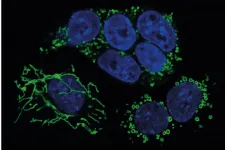(Press-News.org) ROCHESTER, Minn. ? Using data from 9,859 COVID-19 infections, Mayo Clinic researchers have new insights into risk factors for younger populations, some of which differ significantly from their older counterparts. People younger than 45 had a greater than threefold increased risk of severe infection if they had cancer or heart disease, or blood, neurologic or endocrine disorders, the research found. These associations were weaker in older age groups. The study was published in Mayo Clinic Proceedings.
The research team studied people living in a 27-county region of Southeast Minnesota and West Central Wisconsin surrounding Mayo Clinic in Rochester diagnosed with COVID-19 between March and September 2020. The study used the Rochester Epidemiology Project, a linkage of 1.7 million medical records from multiple health care systems that provides a full picture of risks for an entire geographical region.
"Medical care is really fragmented in our country, so someone diagnosed with COVID-19 at one health care provider might end up at a totally different hospital for their severe case. If those records are not linked together, there's really not a good way for us to understand that that is even the same patient," says Jennifer St. Sauver, Ph.D., a Mayo Clinic epidemiologist and the study's first author. "By contrast, the Rochester Epidemiology Project allowed us to follow patients from the time they were diagnosed through their use of health care after that diagnosis, even if they were taken care of at different places. In addition, we could look back in their medical records to better understand all of the chronic diseases this population had even before getting diagnosed with COVID-19 and how those diseases might have contributed to more severe infections."
Among study participants, cancer was the biggest difference in risk comparing people younger and older than 45. For people younger than 45, cancer was a strong risk factor. It was not a significant factor for the older age group.
The researchers also found that people with developmental disorders, personality disorders, schizophrenia and other psychoses had the highest adjusted risk for severe COVID-19 among all chronic conditions.
Like many other studies on risk factors for COVID-19, the researchers found some races and ethnicities were at a higher risk than others. Though only 4.1% of the study population, Asian Americans had the highest risk of severe COVID-19, followed by Black Americans, who made up 11.5% of the severe cases. Hispanic ethnicity also was associated with a higher risk of severe infection.
The team studied positive PCR (polymerase chain reaction) tests for COVID-19 between March 1 and Sept. 30, 2020.
The COVID in our Community Research Study is being conducted by Mayo Clinic, Olmsted County Public Health Services, Olmsted Medical Center, and Zumbro Valley Health Center. The researchers say the project would not have been possible without the Rochester Epidemiology Project.
"The Rochester Epidemiology Project allows us to study diseases, such as COVID-19, in a defined population, which provides the ability to translate our results to all people with COVID-19, not just those with the most severe disease requiring medical care," says senior author Celine Vachon, Ph.D., Chair of the Mayo Clinic Division of Epidemiology. "This type of infrastructure will allow us to follow patients who had COVID-19 in the 27-county region over time to better understand any future links to disease."
INFORMATION:
The project also was supported by the Mayo Clinic Robert D. and Patricia E. Kern Center for the Science of Health Care Delivery and the Mayo Clinic COVID-19 Research Fund.
Co-authors are Guilherme Lopes, Ph.D., Mayo Clinic; Walter Rocca, M.D., Mayo Clinic; Kavita Prasad, M.D., Zumbro Valley Health Center; Michelle Majerus, Olmsted Medical Center; Andrew Limper, M.D., Mayo Clinic; Debra J. Jacobson, Mayo Clinic; Chun Fan, Mayo Clinic; Robert Jacobson, M.D., Mayo Clinic; Lila Rutten, Ph.D., Mayo Clinic; and Aaron Norman, Mayo Clinic.
About the Rochester Epidemiology Project
The Rochester Epidemiology Project is a collaboration of clinics, hospitals, and other medical and dental care facilities in southern Minnesota and western Wisconsin. Founded by Mayo Clinic and Olmsted Medical Center in 1966 in Olmsted County, Minnesota, the collaboration now stretches across 27 counties and includes Olmsted County Public Health Services as its first public health member. This collaboration and sharing of medical information makes this area of Minnesota and Wisconsin one of the few places where true population-based research can be accomplished. For more information about the Rochester Epidemiology Project, view its new historic timeline. Also, visit the Rochester Epidemiology Project website.
About Mayo Clinic
Mayo Clinic is a nonprofit organization committed to innovation in clinical practice, education and research, and providing compassion, expertise and answers to everyone who needs healing. Visit the Mayo Clinic News Network for additional Mayo Clinic news. For information on COVID-19, including Mayo Clinic's Coronavirus Map tracking tool, which has 14-day forecasting on COVID-19 trends, visit the Mayo Clinic COVID-19 Resource Center.
Media contact:
Adam Harringa, Mayo Clinic Public Affairs, newsbureau@mayo.edu
In the largest study of its kind, an investigation by UC San Francisco has found no evidence that moderate coffee consumption can cause cardiac arrhythmia.
In fact, each additional daily cup of coffee consumed among several hundred thousand individuals was associated with a 3 percent lower risk of any arrhythmia occurring, including atrial fibrillation, premature ventricular contractions, or other common heart conditions, the researchers report. The study included a four-year follow up.
The paper is published July 19, 2021, in JAMA Internal Medicine.
"Coffee is the primary source of caffeine for most people, and it has a reputation for causing or exacerbating arrhythmias," said senior and corresponding author Gregory Marcus, MD, professor ...
It is a scenario familiar to anyone who has driven down a crowded, narrow street. Parked cars line both sides, and there isn't enough space for vehicles traveling in both directions to pass each other. One has to duck into a gap in the parked cars or slow and pull over as far as possible for the other to squeeze by.
Drivers find a way to negotiate this, but not without close calls and frustration. Programming an autonomous vehicle (AV) to do the same -- without a human behind the wheel or knowledge of what the other driver might do -- presented a unique challenge ...
Wind energy is of outstanding importance to the energy transition in Germany. According to the Federal Statistical Office, its share in total gross electricity production of about 24% is far higher than those of all other renewable energy sources. "To reach our climate goals, it is important to further expand these capacities and to replace as much coal-based power as possible," says Professor Wolf Fichtner from KIT's Institute for Industrial Production (IIP). "However, there is considerable resistance, especially in beautiful landscapes." A team of researchers from KIT, the University of Aberdeen, and the Technical University of Denmark has now calculated what this means for the costs ...
The photovoltaic effect of ferroelectric crystals can be increased by a factor of 1,000 if three different materials are arranged periodically in a lattice. This has been revealed in a study by researchers at Martin Luther University Halle-Wittenberg (MLU). They achieved this by creating crystalline layers of barium titanate, strontium titanate and calcium titanate which they alternately placed on top of one another. Their findings, which could significantly increase the efficiency of solar cells, were published in the journal Science Advances.
electric crystals do not require a so-called pn junction to create the photovoltaic effect, in other words, no positively and negatively doped layers. This makes it much easier to produce ...
A study led by D. Ross Camidge, MD, PhD, director of thoracic oncology at the University of Colorado School of Medicine and CU Cancer Center member, has helped to define MET amplification as a rare but potentially actionable driver for non-small cell lung cancer (NSCLC).
Camidge says many of the major developments in the treatment of non-small cell lung cancer have come from defining molecularly specific subsets of the disease for which researchers have been able to develop targeted treatments. Until now, all of these subsets have been based on either genetic mutations or gene rearrangements ...
As multicellular life relies on cell-cell interactions, it is not surprising that this is not always peaceful: cells with higher fitness eliminate cells with lower fitness through cell competition. Cell competition has emerged as a quality control mechanism and occurs when cells differ, genetically or otherwise, from each other. In mammals, the process of cell competition has been observed e.g., in cancer, during organ homeostasis, and during development as a process to select the fittest cells in the embryo and the adult. However, the features that distinguish "winner" from "loser" cells and whether there are key determinants for cell competition in various biological ...
PULLMAN, Wash. - When it comes to craft beer, the flavor doesn't have to be all in the hops. As a panel of amateur beer tasters at Washington State University recently demonstrated, malted barley, the number one ingredient in beer besides water, can have a range of desirable flavors too.
Researchers recruited a panel of about 100 craft beer drinkers to taste some so-called SMaSH beers--those brewed with a single barley malt and single hop. All the beers contained the same hop variety, called Tahoma, but each had a malt from a different barley genotype, or genetic makeup. Trained tasters can distinguish these easily, but even the untrained ...
An international group of researchers representing thousands of coral scientists across the globe is calling for new commitments and actions by the world's policymakers to protect and restore coral reefs.
In a paper presented July 20 at the International Coral Reef Symposium, the scientists said that the coming decade will likely offer the last chance for policymakers at all levels to prevent coral reefs "from heading towards world-wide collapse."
The paper, developed by the International Coral Reef Society, pushes for three strategies to save the reefs: addressing climate change, improving local conditions and actively restoring coral. ...
The female tsetse fly, which gives birth to adult-sized live young, produce weaker offspring as they get older, and when they feed on poor quality blood.
The study, carried out by researchers at the Universities of Bristol, Oxford and the Liverpool School of Tropical Medicine, was designed to measure how tsetse offspring health is influenced by their mothers' age, and how factors such as the mother's nutrition and mating experience might come into play.
In many animals, females show signs of reproductive ageing - where offspring health declines with maternal age - but there is huge variation within species in how rapidly this ageing occurs.
Scientists found that female tsetse that experience ...
For more than 20 years, Makoto Miyata from Osaka City University has been studying the gliding motility of the parasitic bacterium Mycoplasma mobile (M. mobile). It is a mechanism consisting of an external "grabbing" structure and internal "motor" - the motor having yet to be clarified on a molecular level. In collaboration with Osaka University and Kanazawa University, his research team used electron microscopy and high-speed atomic force microscopy (high-speed AFM) to reveal that the bacteria's molecular motor consists of two ATP synthase-like complexes, suggesting an unexpected evolution of the protein. Their findings were published in mBio.
Based on genetic information, researchers have suggested that the ...





